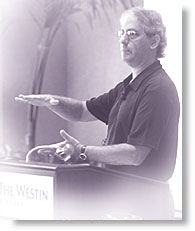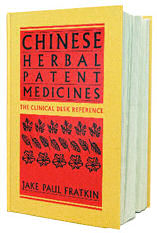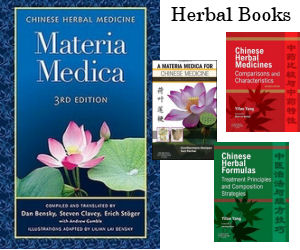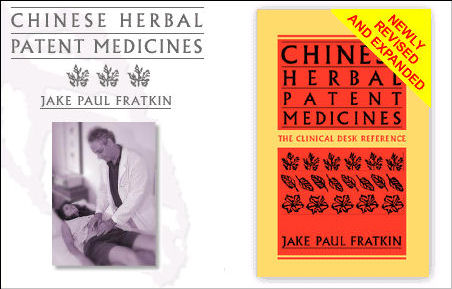Acupuncture & TCM Articles

Articles by Jake Paul Fratkin, OMD, LAc
Jake Fratkin, OMD, LAc, has been in the practice of Oriental medicine since 1978. Following undergraduate and graduate training at the University of Wisconsin in Chinese language and philosophy and pre-medicine, he pursued a seven-year apprenticeship in Japanese and Korean style acupuncture with Dr. Ineon Moon and a two-year apprenticeship in Chinese herbal medicine with Drs. Zhengan Guo and Pak-Leung Lau in Chicago. He also spent a year in Beijing hospitals interning in advanced herbal medicine, specializing in gastrointestinal and respiratory disorders, and pediatrics.  Dr. Fratkin is the author of several books, including Chinese Herbal Patent Medicines: The Clinical Desk Reference, and is the editor-organizer of Wu and Fischer's Practical Therapeutics of Traditional Chinese Medicine. In 1999, he was named the "Acupuncturist of the Year" by the American Association of Oriental Medicine.
Dr. Fratkin is the author of several books, including Chinese Herbal Patent Medicines: The Clinical Desk Reference, and is the editor-organizer of Wu and Fischer's Practical Therapeutics of Traditional Chinese Medicine. In 1999, he was named the "Acupuncturist of the Year" by the American Association of Oriental Medicine.
Chinese Herbal Patent Medicines: The Clinical Desk Reference
Hardback book, 1198 pages. This volume covers 1360 products, including 550 GMP level products and all of California FDB analysis on 505 products. Includes information on endagered animals, heavy metals, and pharmaceuticals. The text is organized into 12 groups, with a total of 109 chapters and includes material by Andrew Ellis, Subhuti Dharmananda, and Richard Ko. Over 80 pages of full-color photos (with English and Chinese cross-reference). Fully indexed.
LEAKY GUT SYNDROME:
A Modern Epidemic
Part 1: The Problem
Originally published for the Great Smokies Diagnositic Lab website.
Also published in: THE POINTS: A JOURNAL OF NEW MEXICO ACUPUNCTURE ASSOCIATION and CALIFORNIA JOURNAL OF ORIENTAL MEDICINE
Leaky Gut Syndrome (LGS) is a major cause of disease and dysfunction in modern society, and in my practice accounts for at least 50% of chronic complaints, as confirmed by laboratory tests. In discussing LGS, I want to first describe the situation in terms of western physiology, and at the end of the article I will discuss aspects of LGS that are unique to Traditional Chinese Medicine.
In LGS, the epithelium on the villi of the small intestine becomes inflamed and irritated, which allows metabolic and microbial toxins of the small intestines to flood into the blood stream. This event compromises the liver, the lymphatic system, and the immune response including the endocrine system. It is often the primary cause of the following common conditions: asthma, food allergies, chronic sinusitis, eczema, urticaria, migraine, irritable bowel, fungal disorders, fibromyalgia, and inflammatory joint disorders including rheumatoid arthritis. It also contributes to PMS, uterine fibroid, and breast fibroid. Leaky Gut Syndrome is often the real basis for chronic fatigue syndrome and pediatric immune deficiencies.
Leaky Gut Syndrome is reaching epidemic proportions within the population. As a disease entity, it has not been discussed in classical or modern TCM literature. In fact, taking a strictly classical Chinese medicine approach to LGS is often ineffective or only partially effective, because the disease is not addressed in all of its complexity.

TCM has never addressed the issue because it is a modern phenomenon. Historically, the only way bowel toxins entered the blood stream was through trauma, for example by sword or spear. This quickly led to septicemia that might be treatable, or more probably, ended in death. Outside of trauma, the body maintained a wonderfully effective selective barrier in the small intestine, one that allowed nutrients to enter, but kept out metabolic wastes and microbial toxins rampant in the intestines.
What modern event allowed such a break-down? Primarily it has been antibiotics, secondarily non-steroidal antiinflammatory drugs (NSAIDs). The first antibiotic, penicillin, did not enter mainstream health care until 1939. Since the 50s and 60s, antibiotic use has been frantically prescribed for every infection and inflammation, particularly pediatric ear infection, bronchitis, and sore throat. It is sadly ironic that most of these infections are viral in nature, and not only are the antibiotics damaging, but they are ultimately unnecessary. Antibiotics should be considered a hospitalization level medicine, when bacteria have entered the blood, bone, or organ.
NSAIDs are commonly taken for various pains, and include ibuprofen (Motrin, Advil). They are quite damaging to the small intestine mucosa lining.
Antibiotics destroy beneficial bacteria
Antibiotics create their damage in two ways. The first is by destroying beneficial bacteria. The small intestine and large intestine host over five hundred different kinds of beneficial bacteria. These bacteria perform hundreds of functions required for healthy metabolism and immune response. Through enzyme secretions, bacteria transform metabolic and microbial wastes before they are discharged by the body. These wastes include cellular debris, hormones, chemical wastes, bile, pus accumulations, viral toxins, bacterial toxins, etc.
For example, the body creates bile not only as a lubricant to flush wastes out of the liver, but also, by its cold and bitter nature, to detoxify many of the poisons accumulating in the liver. Bile however is extremely caustic to large intestine epithelium. When bile enters the small intestine via the common bile duct, beneficial bacteria break the bile salts down into a less caustic compound, making it non-dangerous by the time it reaches the large intestine. When you take antibiotics you destroy these bacteria and the bile salts freely enter and damage the large intestine. I believe this contributes significantly to the high incidence of colon cancer plaguing today´s society.
Beneficial bacteria also break down hormone secretions that are discharged from the liver to the small intestine. If you lack the bacteria to break down estrogen and the intestinal permeability has been altered, the patient is now reabsorbing estrogens in their original state. The body will deposit these in estrogen sensitive areas such as the breast, uterus, or ovaries, contributing, if not causing, fibroids and tumors. The same scenario is responsible for premenstrual syndrome as well.
Antibiotics Promote the Growth of Fungus
The second way antibiotics damage the intestines is by fostering the growth of Candida Albicans and other pathogenic fungi and yeast. This event, more than any other, precipitates Leaky Gut Syndrome. In a healthy situation the small intestine epithelium maintains tight cell junctions, which contributes to the physical barrier involved in intestinal absorption. In addition to the physical barrier, there is an important chemical barrier within the mucus that contains immune agents which neutralize any toxin that comes in contact.
Candida exudes an aldehyde secretion which causes small intestine epithelial cells to shrink. This allows intestinal toxins to infiltrate through the epithelium and into the blood. The secondary barrier - immune agents in the epithelial mucus -remain the sole agent for neutralization. Eventually, the immune system becomes exhausted rising to this challenge.
Many people have an erroneous belief that the Candida itself enters the blood stream, allowing it to be deposited elsewhere, such as the brain. Unless the immune response is completely depleted, as in AIDS, Candida is quickly destroyed in the blood. The real damage done by Candida is to the intestinal epithelial barrier, allowing the absorption of serious toxic agents and chemicals, which then enter the blood and affect numerous organs, including the brain.
Food Allergies: The Complicating Factor
When the integrity of the intestinal barrier has been compromised, intestinal toxins are not the only pathogens to be absorbed. The barrier, in a healthy state, selectively allows digested nutrients to enter the small intestine when all is ready. With leaky gut, nutrients can be absorbed before they are fully digested. The body´s immune response, through specific antigen-antibody markers, will tag some of these foods as foreign irritants. Every time that particular food touches the epithelia, an inflammatory immune response is mounted which further damages the epithelial lining. What started as a Candida irritation with shrinking of the cells has now been complicated with active inflammation every time a particular food is eaten. Food allergies are a common secondary problem to Candida, and if present, will maintain the leaky gut continuously, even if the Candida is eradicated.
The most common food allergies are dairy, eggs, gluten grains (wheat, oats, rye), corn, beans (especially soy), and nuts. There are seldom real allergies to meat, rice, millet, vegetables, or fruit, although an allergy to garlic is not uncommon. We have to distinguish a real allergy - that which causes a histamine inflammatory reaction at the site of the SI epithelia - from sensitivity, which may cause uncomfortable symptoms, but seldom is damaging. Sensitivities are usually due to low stomach acid or pancreatic enzyme secretion, that is, poor digestion.
In the healing of the intestinal lining, exposure to a significant allergy can sabotage the treatment. For example, one may be very good at restricting wheat, dairy and eggs, but then compromises the treatment by taking garlic tablets.
The Role of the Liver and Lymphatic System
The metabolic and microbial toxins that enter the bloodstream during leaky gut end up in the liver, which has the job of detoxifying and discharging the poisons. Under normal conditions, the liver is taxed just by processing the daily metabolic wastes created by cell and organ activity. Imagine the further load created by dumping serious intestinal toxins on a regular basis. There is a point when the liver becomes saturated; it cannot further detoxify the poisons, and they are returned to the blood circulation. The blood has sophisticated mechanisms for preserving chemical homeostasis, and will diffuse as much of the toxic chemicals and physical debris into the interstitial fluids as is possible. From here the lymphatic system will attempt to collect and neutralize the toxins, but unable to send the toxins to the liver, the body essentially becomes toxic. Microbes grow and develop, hence there can be chronic lymphatic swelling, especially in children. Over a period of time, toxins will be forced into distal connective tissue around muscles and joints, causing fibromyalgia, or into the cells, which can precipitate genetic mutation and ultimately cancer.
Stress to the Immune and Endocrine Systems
The immune system is stressed in three major ways. First is at the site of the intestinal mucosa. As toxins and food antigens brush up against the mucosa, the immune system mobilizes to neutralize the toxins. Normally, much of this work would have been done by beneficial bacteria, which have been destroyed by antibiotics. For toxins that make it to the mucosa, the body will tag them with a chemical secretory IgA (SIgA), which attracts macrophages and other white blood cells to consume the toxins. It is not long before this immune response is overwhelmed and depleted. This can be measured directly with a stool or saliva test for the intestinal SIgA level.
The second stressor happens in the liver and lymphatic system which, also overwhelmed, puts demands on the immune system. The third stressor is a consequence: as the immune response diminishes, more microbes (viruses, bacteria, and fungi) multiply, allowing for a chronic state of infection. What might be tagged as a viral infection, such as Epstein-Barr virus for Chronic Fatigue Syndrome, is actually an opportunistic infection taking advantage of a weakened immune system .
The most important organ in the production of immune agents seems to be the adrenal gland, and Leaky Gut Syndrome slowly diminishes adrenal function. In the early and middle stages, there is actually an adrenal excess, as measured by excess cortisol output. Eventually, cortisol levels drop, and one now has exhaustion.
The Role of the Digestive Tract
Candida flourishes when the terrain in the intestines favors it. Just killing Candida is usually not successful, because the chemistry and vitality of the terrain has not been normalized, and Candida returns. Antibiotics are the original cause of the change on the terrain. By killing acid forming bacteria (Lactobacillus bacteria produce lactic acid, for example), the environment becomes alkaline, which promotes Candida. Antibiotics and chronic illness reduce stomach acid production, contributing to the alkalinity, and also allowing poor digestive absorption. In fact, many people with LGS are malnourished, no matter how healthy the food is that they eat.
The terrain of the small intestine requires proper pH and electromagnetic resonance. The idea that lactobacillus supplementation is all that is required after antibiotics is somewhat delusional; in fact most of the lactobacillus from supplementation does not survive in the intestine, due to poor terrain.
Organizing the Therapy
Leaky Gut Syndrome has various components, all of which need to be evaluated and addressed. First, ongoing irritants to the small intestine mucosal lining (fungus, food allergies, and NSAIDs) need to be identified and neutralized. Second, nutrients and herbs are required to promote healing of the epithelial lining. Third, and perhaps the key link, the liver needs to be regulated. Fourth, the lymphatics and interstitial fluids need to be detoxified. Fifth, the immune and endocrine systems need to be regulated and supported. And sixth, the stomach and pancreas needs to be regulated, if necessary.
The therapy takes between four and eight months. Patients need to be vigilant about their diet in avoiding food allergies and minimizing the growth of Candida.
Understanding Leaky Gut Syndrome in Terms of TCM.
Antibiotics introduce a very cold environment into the digestive system. It depletes spleen yang and disrupts spleen-stomach harmony. This impairs digestion and absorption of food and fluids, and more important, depletes the qi necessary to maintain the integrity of the small intestine. The small intestine is controlled by the spleen. The spleen´s function of absorption and distribution of qi and fluid happens in the small intestine, and the function of the SI is controlled by the Stomach and Spleen channels (not the Small Intestine channel). So, the initial damage to the integrity of the small intestine is due to damage of the spleen function.
We can understand the small intestines discharging toxins to the liver in terms of spleen insulting liver, that is, a reverse control within the wu xing (five phase) cycle. The liver will become excess, causing a stagnation of qi and blood. Its ability to store and distribute the blood (which includes the ability to cleanse the blood) becomes impaired. This is the main excess in an array of other deficiencies (spleen, kidney), and as such, becomes the pivotal key-link that needs to be addressed first. Zang-Fu therapy usually requires that the excess be addressed at the beginning.
When the spleen becomes depleted, the kidney will become excess, according to wu xing theory. Initially, the body responds with a kidney yang excess, to try to reinforce the yang that has been depleted in the spleen. This will manifest as stress, anxiety, and poor sleep. (It is directly measurable as an elevated adrenal cortisol level.) Over a period of time, kidney yang will begin to become depleted, leading to fatigue. Over a longer period of time, both kidney yang and yin will be come depleted, leading to a depletion of the yuan-jing reserves, resulting in true exhaustion.
The combined depletion of kidney and spleen, with depletion of the yuan-jing reserves, significantly depletes the ying qi flowing through the channels. Wei qi, being the active radiating yang aspect of the ying qi, is also depleted, diminishing an effective response to pathogenic factors. The whole stomach and intestinal tract is still considered the outside of the body, and as such, depends on wei qi to keep pathogenic factors from entering. As the wei qi is reduced, pathogenic toxins are free to enter the body and further sap its reserves of energy.
Successful rehabilitation requires that the ying and wei be restored to normal levels, through regulation of the spleen and kidney. This tonification of the wei qi will help regenerate tissue on the surface of the small intestine. Again, it is required that the blockage and congestion at the liver be allowed to open up again, or, in terms of TCM, dredged.
Underlying the susceptibility to Leaky Gut Syndrome is the probability that the qi is deficient to start with. This goes back to a modern lifestyle of poor eating habits and poor food choices which injures the spleen, and the various stresses of modern life (lifestyle, chemicals, electromagnetic) that depletes kidney qi. Within the acupuncture network, this contributes to a weakened dant ian, or hara. The small intestine lies over and around the dantian. This is one of the most important energy centers in the body, the place where food is converted to qi and blood. When the dant ian becomes weakened, it creates a terrain that allows LGS to take place. And it indicates that a successful adjunct to therapy would include dant ian qi gong.
Conclusion
People worry about many sorts of environmental toxins: vaccinations, dental amalgams, pesticides, herbicides, food additives, chlorine, etc. It is true that all of these are stressors on the body, and contribute to an overall decline in health. The worst threat, however, is an ongoing toxic intrusion from the cesspool that exists in our intestines. The body has a marvelous mechanism, a selective intestinal permeability, that allows digested nutrients in while keeping toxins meant for excretion out. Throughout history, in general, this barrier has maintained its integrity. During the last fifty years, due to the intrusive irritation of antibiotics and NSAIDs, the average person´s health has been significantly challenged and weakened.
 
|
